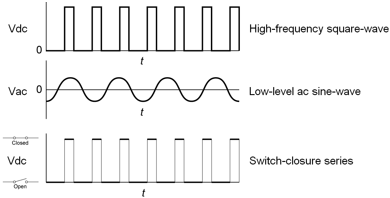Pulse measurements
The output signal generated by a pulse sensor is a series of voltage waves. The sensor couples its output signal to the measured phenomenon by modulating wave frequency. The data logger detects the state transition as each wave varies between voltage extremes (high-to-low or low-to-high). Measurements are processed and presented as counts, frequency, or timing data.
The data logger includes terminals that are configurable for pulse input as shown in the following image.
| Input type | Pulse input terminal |
|---|---|
| High-frequency |
|
| Low-level AC |
P2 |
| Switch-closure |
P2 C (all) |
Using the PulseCount() instruction,
Conflicts can occur when a control port pair is used for different instructions (TimerInput(), PulseCount(), SDI12Recorder(), WaitDigTrig()). For example, if C1 is used for SDI12Recorder(), C2 cannot be used for TimerInput(), PulseCount(), or WaitDigTrig().
Output can be recorded as counts, frequency or a running average of frequency.
For more information, see Pulse measurement specifications.
See the CRBasic Editor help for detailed instruction information and program examples: ![]()
